My baked salmon recipe comes out flaky and tender in just 20 minutes! I use simple seasonings, olive oil, and lemon juice to create a quick and flavorful meal I feel really good about feeding my family.
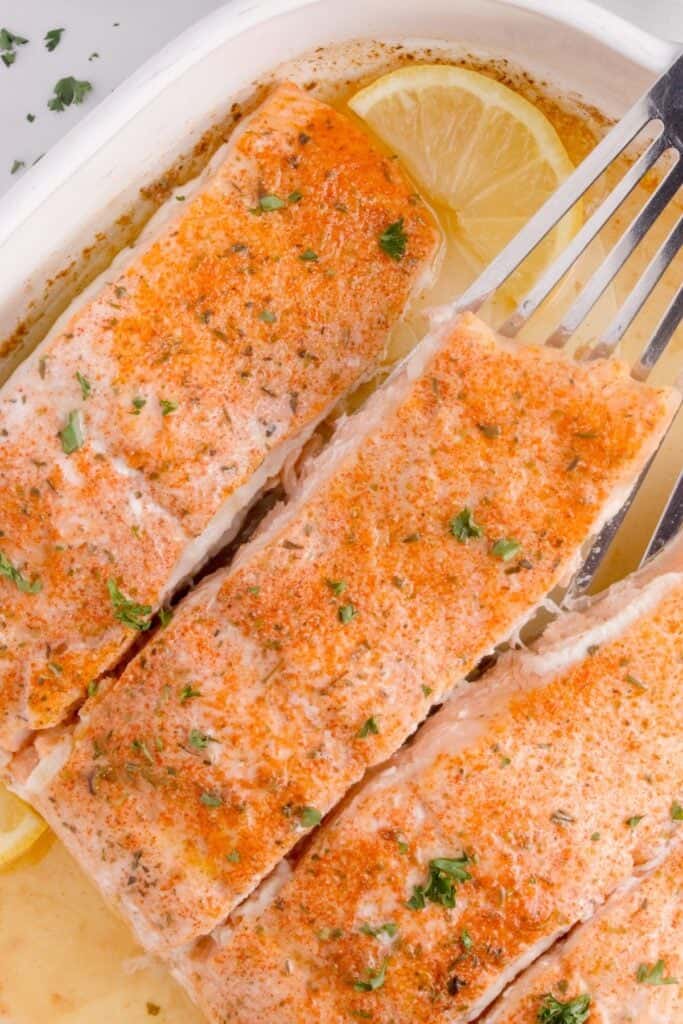
This post may contain affiliate links. If you click on a link and make a purchase, I may receive a small commission at no extra cost to you. For more information, please read my disclaimer.
My Favorite Recipe for Salmon in the Oven
Growing up, I remember my mom making her baked salmon recipe pretty often. It’s easy, can be paired with just about everything, and my dad and all of us kids loved it. I know the latter was most important for my mom!
Many years later when I married my husband Ben, her very same recipe became a staple meal. To this day, it has remained one of my family’s favorites! It’s one of those meals that can be served for both special occasions and on any ordinary day, which happens to be why I like it so much.
And while I love it cooked any way, including on the grill or on the stove top, salmon in the oven is my favorite method for busy nights when I want to keep things simple. It’s such an easy set-and-forget recipe that can be prepped and popped into the oven without much effort.
Need even more salmon recipes? Try my air fryer salmon, Ninja Foodi salmon, salmon patties, and my recipe for frozen salmon in the air fryer next.
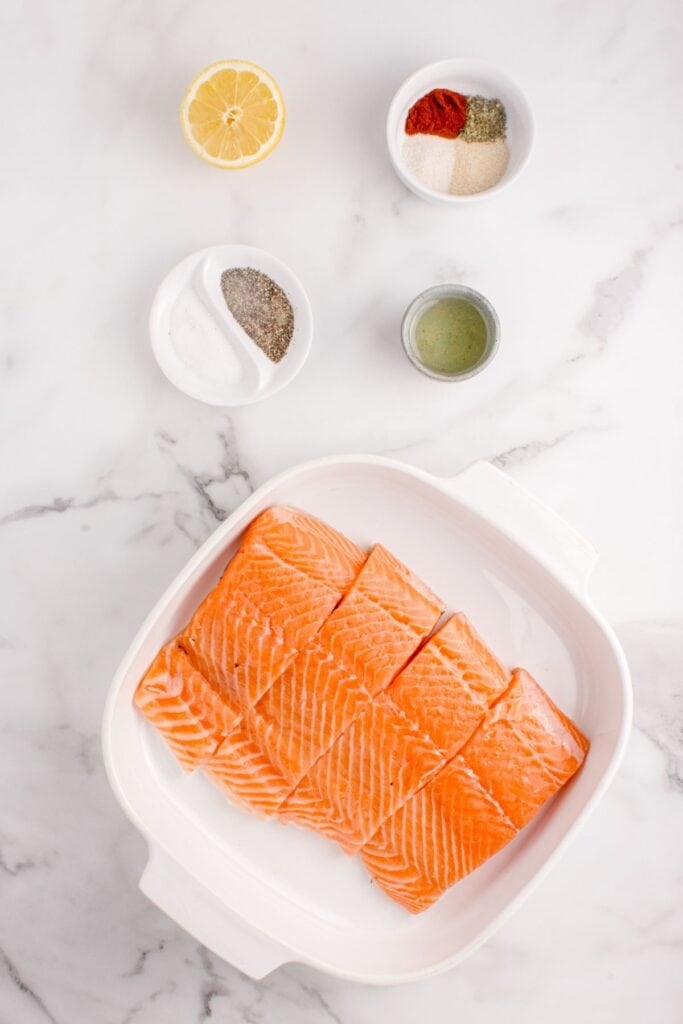
Oven Baked Salmon Ingredients
- Salmon fillets – I always try to use evenly sized cuts to ensure even cooking.
- Onion powder – I love the way its natural sweetness balances out the homemade spice mixture.
- Garlic powder – Makes the recipe savory without burning like fresh garlic can.
- Italian seasoning – This blend of earthy, peppery herbs adds so much depth! I typically just reach for store-bought.
- Paprika – I love smoked paprika for its rich, smoky flavor and pop of color.
- Salt and pepper – Enhance the natural flavor of the salmon.
- Olive oil – To help all of the seasonings stick!
- Lemon juice – I add a drizzle of lemon juice to brighten the overall flavor.
What to Look For When Shopping for Salmon
Whenever I shop for salmon, there are usually a few different options at the store, so I always make sure to compare the taste, texture, and price point.
I’ve always loved Atlantic salmon because of its mild flavor and flaky texture. Now, if I’m looking for a rich, buttery flavor and texture, I go with king salmon! I typically find that sockeye salmon has a firmer texture and more robust flavor.
The best type of fish for my baked salmon recipe will ultimately depend on personal preference, but for me, the most important factor is freshness. I only choose salmon with firm flesh and no discoloration — both are signs of fresh fish!
How to Cook Salmon in the Oven
A full printable version of this recipe with ingredient measurements is available at the bottom of this post.
STEP ONE: Preheat the oven to 400 degrees F and line with parchment paper or aluminum foil (optional, but helpful for easy cleanup).
STEP TWO: Pat each salmon fillet dry with a paper towel to remove excess moisture.
STEP THREE: In a small bowl, combine the onion powder, garlic powder, Italian seasoning, paprika, salt, and black pepper. Brush the rimmed baking sheet with the olive oil to prevent sticking.
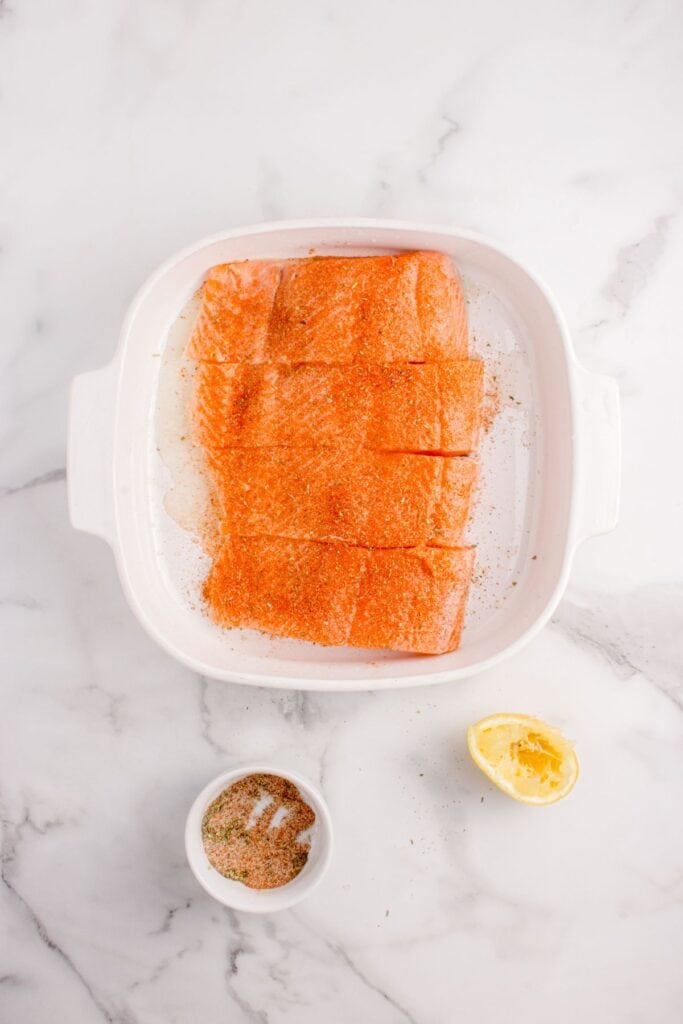
STEP FOUR: Place the salmon skin-side down on the prepared baking sheet. Drizzle the lemon juice over the salmon, then sprinkle the spice mixture evenly over each fillet.
STEP FIVE: Cover the salmon with aluminum foil (optional for more tender salmon) and bake it for 12–15 minutes, making sure to adjust the bake time based on the salmon’s thickness. It’s ready when it flakes easily with a fork and has reached a safe internal temperature of at least 145 degrees F for a medium rare.
STEP SIX: To add an optional finishing touch, broil for 1-2 minutes to create a crispy crust.
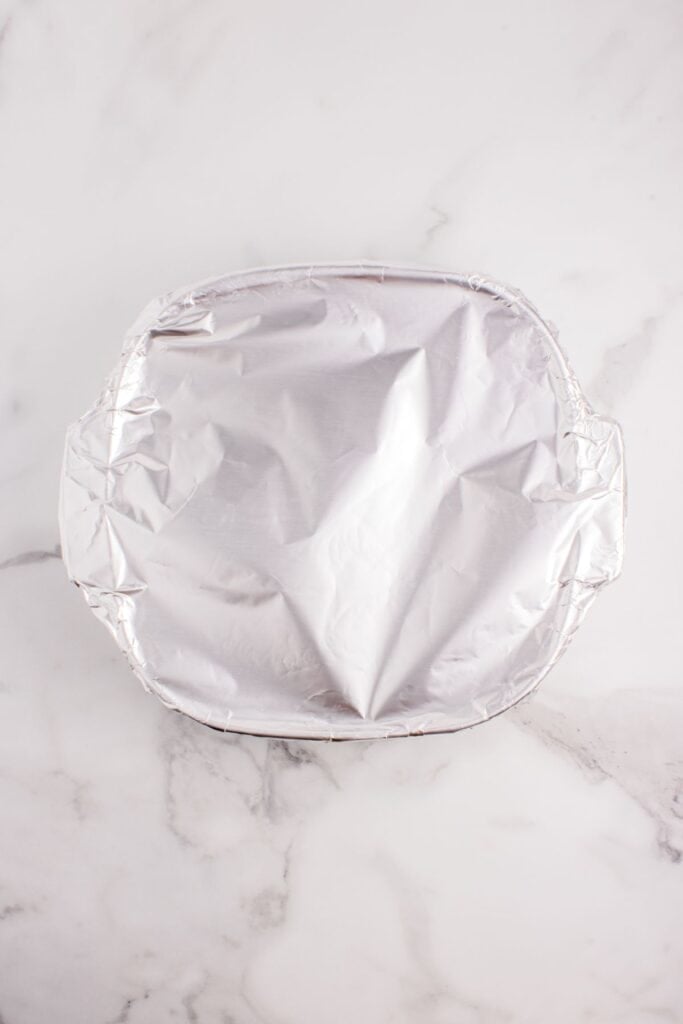
Tips for the Best Baked Salmon Recipe
- Line the baking tray with parchment paper or aluminum foil. This is my favorite tip for an easy cleanup!
- I always dry the salmon with paper towels before seasoning to remove excess moisture. It always gives me the crispiest skin!
- I leave the fish sitting at room temperature for 10 minutes before baking so it cooks evenly.
- For the most tender salmon, I like to cover the fillet with an additional layer of foil before baking. It works like a charm!
- Check the thickness of the fish. I always adjust the baking time if the fish is thinner or thicker than 1 inch so nothing gets over (or under) cooked.
- Allow the fish to rest for 2 to 3 minutes before serving to keep it nice and juicy!
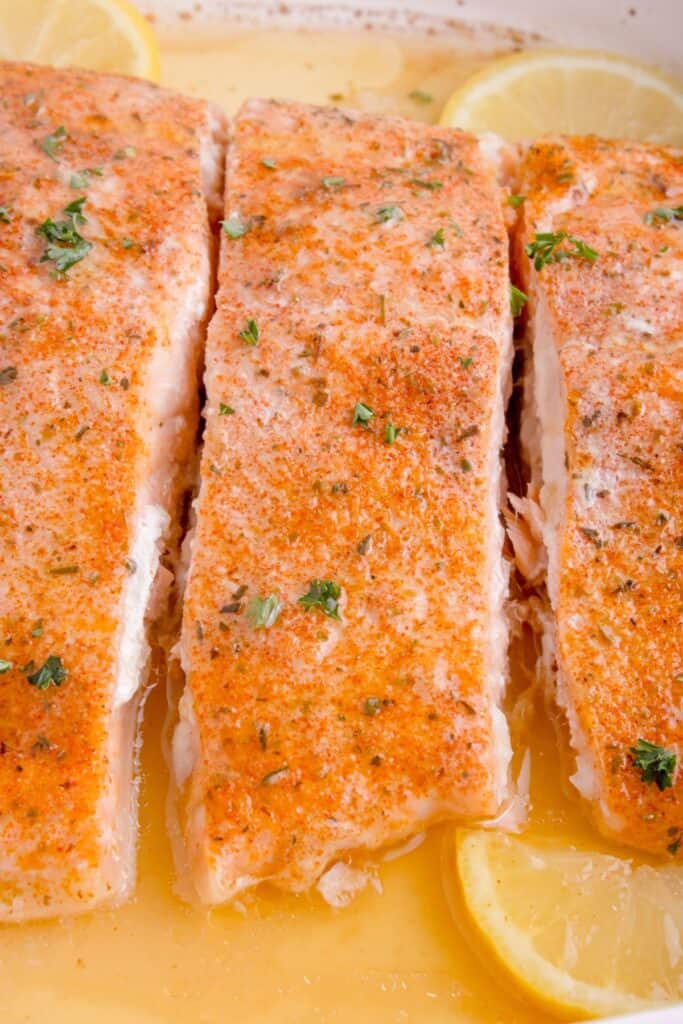
Salmon Recipe Variations and Substitutions
- To make a sweeter salmon dinner, I like to add a little bit of honey.
- If I want to give the recipe a savory twist, some Dijon mustard does the trick!
- And, to bring on the heat, a sprinkle of red pepper flakes is all I need. Or, a few extra dashes of hot sauce for my spicy-food-loving husband.
- I’ve also used this recipe to cook a full side of salmon instead of just fillets! It will take a bit longer to cook (20-25 minutes at 400 degrees F), but it definitely serves a crowd.
- For a milder flavor, swap out the black pepper and use white pepper instead.
- Garnish with fresh herbs, such as chopped dill, parsley, or chives. I think this really elevates flavor and appearance for special occasions!
- Topping it with a sauce, like a creamy lemon dill sauce, will add even more flavor!
What to Serve with Oven Baked Salmon
Salmon is so versatile and goes with so many different sides. I love pairing it with veggies like my baked asparagus or garlic green beans. Some simple white rice or air fryer baby potatoes never fail to round out the meal either!
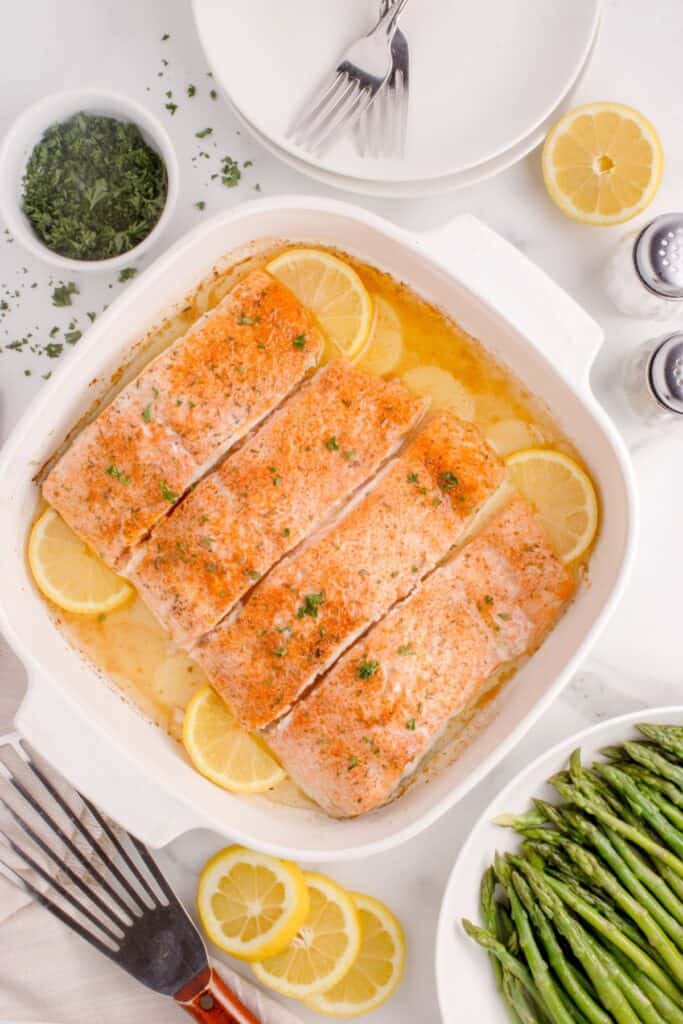
Baked Salmon Recipe FAQs
Do I need to remove the skin off salmon?
No! Salmon skin is safe to eat, crisps up nicely, and peels off easily after baking. It may be an unpopular opinion, but it’s actually one of my favorite parts!
What internal temperature should baked salmon be cooked to?
Salmon is done cooking when its internal temperature reaches 145 degrees F at the thickest part. An instant-read thermometer is the easiest way to measure this! For a more tender salmon, it can be cooked to just 125 degrees F for a more medium rare cooked fish.
How long to bake salmon
The exact amount of time needed to bake salmon will depend on the thickness of the fish. Thicker pieces will take longer than thinner pieces. At 400 degrees F, it will take 12 to 15 minutes to cook.
What should I do with leftover salmon?
I transfer leftover salmon to an airtight container and store it in the refrigerator for up to 2 days. For longer storage, I put the fish in foil or plastic wrap, then place it in a freezer bag for up to 1 month. Frozen salmon should be thawed overnight in the fridge before reheating.
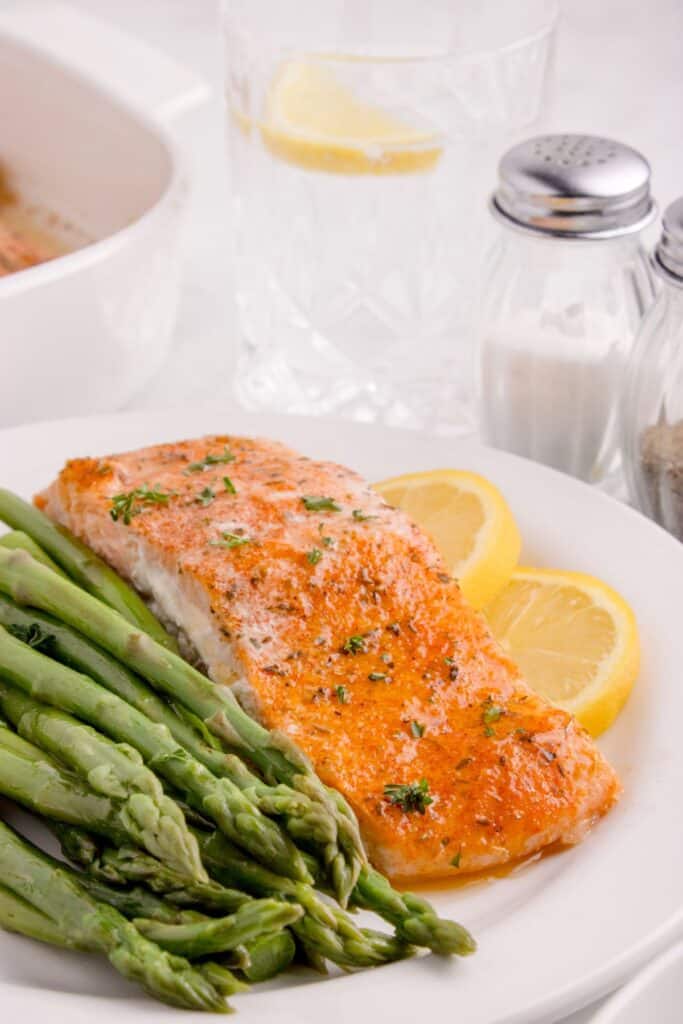
More Easy Seafood Recipes
- Baked tilapia recipe
- Shrimp scampi
- Tuna steak recipe
- Air fryer mahi mahi
- Shrimp fried rice
- Blackened mahi mahi

Easy Baked Salmon Recipe
Ingredients
- 4 salmon fillets
- 1 teaspoon onion powder
- 1 teaspoon garlic powder
- 1/2 teaspoon Italian seasoning
- 1/2 teaspoon paprika
- 1 teaspoon kosher salt
- 1/2 teaspoon black pepper
- 1 tablespoon olive oil
- 2 tablespoons lemon juice
Instructions
- Preheat the oven to 400 degrees F and optionally line a rimmed baking sheet with parchment paper or aluminum foil for easy cleanup.
- Pat each of the salmon fillets dry with a paper towel.
- In a small bowl, mix together the onion powder, garlic powder, Italian seasoning, paprika, salt, and black pepper. Brush the rimmed baking sheet with the olive oil to prevent sticking.
- Place salmon fillets skin-side down on the prepared baking sheet. Drizzle the lemon juice over the salmon fillets, then sprinkle the spice mixture evenly over each fillet.
- Cover the pan with aluminum foil (optional for more tender salmon) and bake the salmon for 12–15 minutes (adjust the bake time based on the salmon's thickness). The salmon is done when it flakes easily with a fork and its internal temperature reaches 145 degrees F at the thickest part.
- Broil for 1-2 minutes for a crispy crust (optional).
Notes
- Line the baking tray with parchment paper or aluminum foil for easy cleanup!
- Always dry the salmon with paper towels before seasoning to remove excess moisture for a more crispy skin.
- Let the fish sit at room temperature for 10 minutes before baking so it cooks evenly.
- Cover the salmon with an additional layer of foil before baking for a more tender salmon.
- Check the thickness of the fish. I always adjust the baking time if the fish is thinner or thicker than 1 inch so nothing gets over (or under) cooked.
- Allow the fish to rest for 2 to 3 minutes before serving to keep it nice and juicy!
- Store leftovers in an airtight container in the refrigerator for up to 2 days.
Nutrition
This nutrition information is based on the exact products I used in this recipe. Brands and sizes of products could alter exact nutrition and should always be calculated independently.

